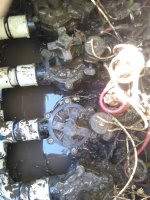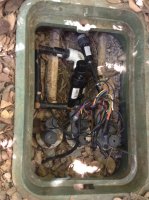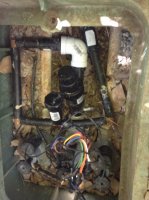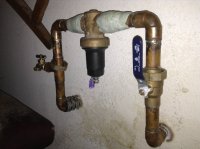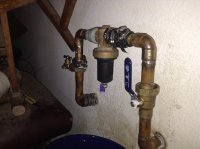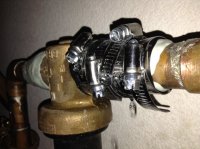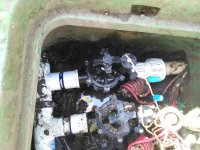Jvstevens
Member
I have an irrigation valve box (containing 4 Hardie in-line valves) that has filled with water indicating a leak, so I bailed out the water and dug out the mud and have discovered two leak sources. The first one is leakage from around the stem of the flow control valve on valve #3. When I close the flow control valve, the leaking stops. The second leak is on valve #1, at the joint between the valve inlet port and the PVC male adapter. Just a small dribble (say a couple of drops per second) of water coming out of the gap between the two, as though the joint was not adequately tightened. It would be a nightmare to try to replace the valves, since space is so tight, so I'm determined to fix both leaks in-situ. I have attached a picture. The #1 valve is at the top.
Also, valve #3 does not turn on the water. It just seems to spit out air, but no water goes out the valve. I think the leak at the stem is related to this problem, but not totally sure.
I'm not familiar with Hardie valves, but after a bit of searching, I think I have found the latest version of my valve. Its not an exact match, but very close. Hopefully someone with familiarity with Hardie can confirm. Here is a picture and parts breakdown:
https://www.irrigationdirect.com/pr...-repair-parts/hardie-100-series-1-1-12-valves
https://www.irrigationdirect.com/pr...-repair-parts/hardie-100-series-1-1-12-valves
Leak #1: Looks to me like if I just replace the o-ring (item #2), that should cure the flow control valve stem leak, yes? Also, should the valve start working after that, or could it be another problem, like a bad diaphragm (item 12 in the link)?
Leak #2: What's the best way to plug up a leak like this? Apply sealant/epoxy around the joint (360 degrees)? What's the best epoxy/sealant to use? Or is there another solution?
Thanks in advance. All help is appreciated.
Also, valve #3 does not turn on the water. It just seems to spit out air, but no water goes out the valve. I think the leak at the stem is related to this problem, but not totally sure.
I'm not familiar with Hardie valves, but after a bit of searching, I think I have found the latest version of my valve. Its not an exact match, but very close. Hopefully someone with familiarity with Hardie can confirm. Here is a picture and parts breakdown:
https://www.irrigationdirect.com/pr...-repair-parts/hardie-100-series-1-1-12-valves
https://www.irrigationdirect.com/pr...-repair-parts/hardie-100-series-1-1-12-valves
Leak #1: Looks to me like if I just replace the o-ring (item #2), that should cure the flow control valve stem leak, yes? Also, should the valve start working after that, or could it be another problem, like a bad diaphragm (item 12 in the link)?
Leak #2: What's the best way to plug up a leak like this? Apply sealant/epoxy around the joint (360 degrees)? What's the best epoxy/sealant to use? Or is there another solution?
Thanks in advance. All help is appreciated.

